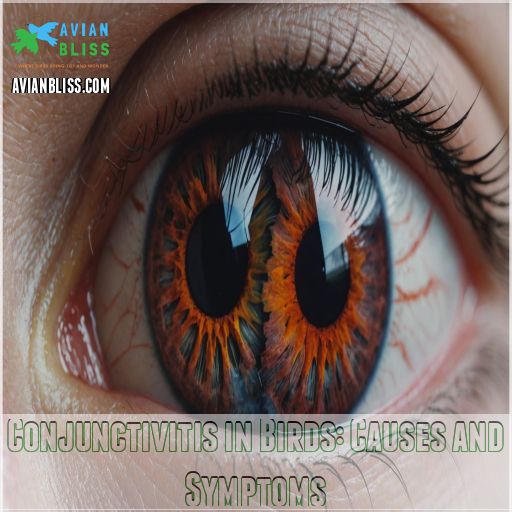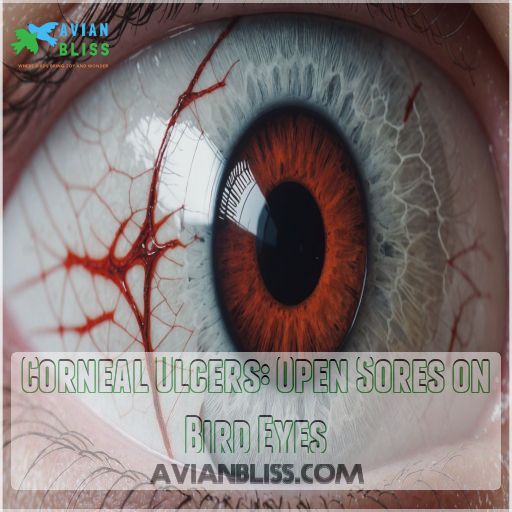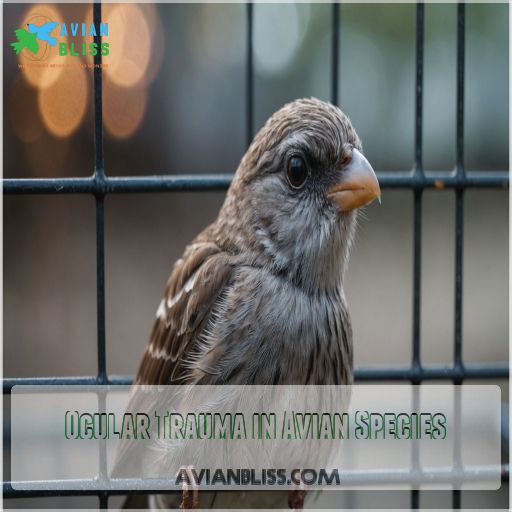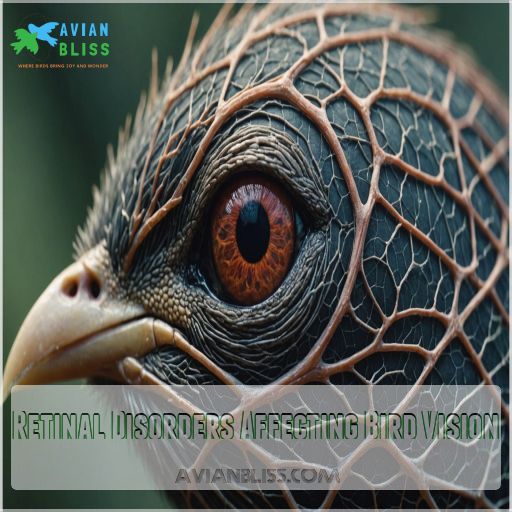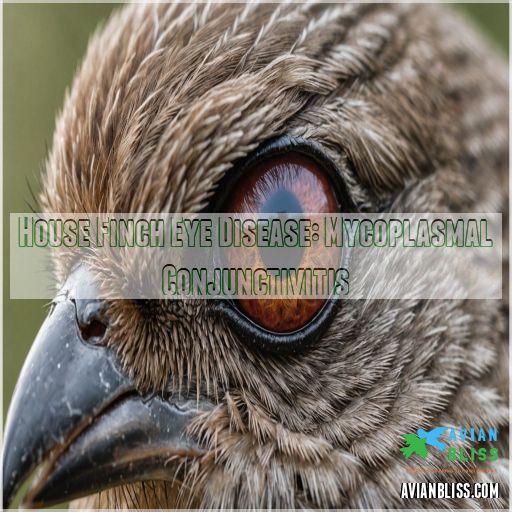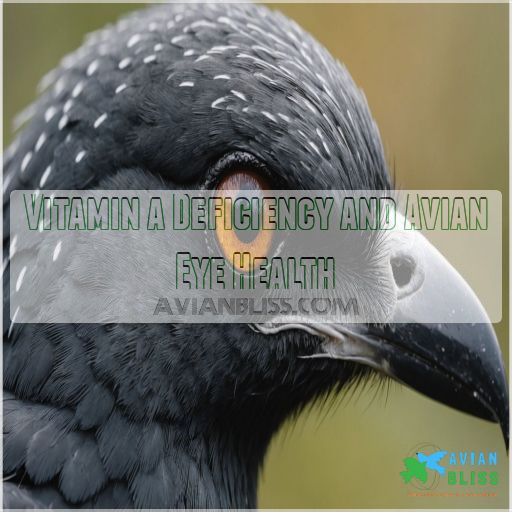This site is supported by our readers. We may earn a commission, at no cost to you, if you purchase through links.
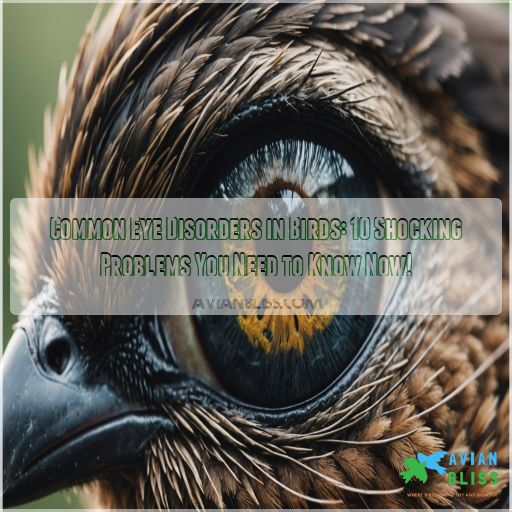
Birds can suffer from conjunctivitis, which makes their eyes look like they’ve been crying over spilled seeds. Cataracts might cloud their vision like a foggy morning, often due to a lack of Vitamin E or a genetic lottery they didn’t win.
And don’t forget chlamydiosis, a sneaky bug that irritates their peepers and could jump ship to humans. If you’re raising birds, knowing these troubles keeps you a step ahead.
Curious about how to treat these avian eye issues? Stay tuned for an update on how to handle these common eye disorders.
Table Of Contents
- Key Takeaways
- Conjunctivitis in Birds: Causes and Symptoms
- Cataracts: Clouding of the Avian Eye Lens
- Chlamydiosis (Psittacosis) and Its Ocular Effects
- Glaucoma in Birds: Pressure and Vision Loss
- Corneal Ulcers: Open Sores on Bird Eyes
- Ocular Trauma in Avian Species
- Retinal Disorders Affecting Bird Vision
- House Finch Eye Disease: Mycoplasmal Conjunctivitis
- Vitamin a Deficiency and Avian Eye Health
- Diagnosing and Treating Bird Eye Disorders
- Frequently Asked Questions (FAQs)
- What are the four most common eye problems?
- What is the disease in the eye of birds?
- What’s wrong with my bird’s eye?
- What does a bacterial eye infection look like?
- How can avian pox affect a birds vision?
- What is the role of feeder hygiene in preventing eye diseases?
- Are leucism or albinism related to eye disorders in birds?
- Can environmental factors like pesticides impact bird eye health?
- How do reflective surfaces contribute to bird eye injuries?
- Conclusion
Key Takeaways
- Keep an eye on those sneaky conjunctivitis symptoms, like red, swollen eyes and crusty discharge. It’s as if your bird is auditioning for a role in a tear-jerking drama. Clean environments and good hygiene are your best friends here.
- When it comes to cataracts, they’re the foggy-window thieves of your bird’s vision. Make sure to include vitamin E in their diet and consider the genetic elements that could cloud their vision.
- Chlamydiosis is the sneaky bug that can affect both birds and humans. Stay ahead of the game by understanding transmission methods and ensuring proper disinfection to keep everyone, including yourself, safe from this stealthy opportunist.
- Don’t let environmental factors give your bird the old lemon-splash-in-the-eye routine. Keep them clear of dust, smoke, and those pesky reflective surfaces that could lead to perilous collisions. Birdie-friendly zones are the way to go.
Conjunctivitis in Birds: Causes and Symptoms
You mightn’t realize it, but your feathered friend’s eyes are vulnerable to a surprising array of issues.
Conjunctivitis, an inflammation of the eye’s outer surface, is one of the most common eye disorders in birds.
Knowing its causes and symptoms can help you catch it early.
Bacterial Conjunctivitis
Your bird’s eyes might be in for a rough ride with bacterial conjunctivitis. This eye-opener of an infection can turn your feathered friend’s peepers into a red, swollen mess .
- Thick, crusty discharge around the eyes
- Excessive blinking or squinting
- Rubbing or scratching at the affected eye
Don’t let your birdie suffer in silence! Common culprits include Chlamydia and E. coli, so keep those cage-cleaning skills sharp to prevent these pesky bacteria from taking flight.
Viral Conjunctivitis
Viral conjunctivitis in birds is often caused by avian poxvirus or infectious bronchitis.
Symptoms include eye redness, swelling, and thick discharge that can crust over.
While some birds recover on their own, veterinary treatment with antiviral medications may be necessary to prevent blindness or systemic infection.
Fungal Conjunctivitis
Spotting fungal conjunctivitis in birds can be as tricky as finding a needle in a haystack. Look for eye redness, swelling, and cloudy eyes.
Diagnosis requires a vet’s expertise, offering treatment options like antifungal medication.
To prevent this pesky eye disorder, keep your bird’s environment clean and dry – avoid damp, moldy spots that fungi love.
Environmental Irritants
Birds’ eyes can be quite sensitive to environmental irritants like dust, smoke, and pollen, leading to ocular trauma. Imagine your bird encountering a cloud of perfume—it won’t thank you for it!
Chemicals and mold also play sneaky roles, causing irritation akin to corneal ulcers or even exacerbating vitamin A deficiency.
Keep your feathered friend’s space clean and free from these hazards, providing a safe environment to prevent such issues from occurring in the first place, and minimize the risk of experiencing any further corneal ulcers, especially when they exhibit unusual behaviors like yawning in birds
.
Clinical Signs of Avian Conjunctivitis
Shifting gears from environmental irritants, let’s chat about clinical signs of avian conjunctivitis.
Imagine your feathered friend looking a bit under the weather:
- Discharge: Think of a crusty morning eye—a sign something’s amiss.
- Swelling and redness: Those puffy eyes need attention.
- Squinting: Like you trying to read tiny print!
- Crusting and avoidance: Signals they need care and perhaps better bird nutrition.
Cataracts: Clouding of the Avian Eye Lens
When you notice your bird’s eyes getting cloudy, like a car window before you remember your glasses, it’s probably cataracts creeping in.
These vision thieves can be caused by nutritional gaps, a bump to the head, or just a bad roll of the genetic dice.
So it’s important to keep an eye on them—pun intended, and especially because they are vision thieves.
Nutritional Deficiencies Leading to Cataracts
After addressing conjunctivitis, it’s time to chat about cataracts.
They blur a bird’s vision like a foggy window, and guess what, just like bird glass collisions
? Dietary tweaks can help! Vitamin E plays a heroic role in cataract prevention.
Make sure your feathered friend’s diet includes leafy greens and supplements, alongside considering vitamin A sources to fend off potential vision impairment.
Genetic Predisposition to Avian Cataracts
Imagine your bird’s eyes as priceless treasures. Genetic predisposition can turn their lenses cloudy, like morning fog.
Some avian cataract breeds might face inherited eye diseases, but fear not—you can maintain parrot health through genetic testing and smart breeding practices.
Though cataract surgery exists, prioritizing prevention is key. Consider supplementing with vitamin E to safeguard your feathered friend’s vision.
Trauma-Induced Cataracts
Trauma can take a serious toll on your bird’s eyes, leading to painful and vision-impairing cataracts.
Blunt force injuries, electrical shocks, and even feisty cage mates can all contribute to this clouding of the lens .
Prompt veterinary care is essential to prevent further complications like uveitis and lens luxation .
Cataract Progression and Vision Impairment
As cataracts progress, your feathered friend’s vision impairment may become apparent. Keep an eye out for these signs:
- Bird blindness sneaks up, but they adapt remarkably well.
- Vision rehabilitation includes helping them navigate safely.
- Cataract surgery may be an option, though it’s complex and not always necessary.
Maintaining a consistent environment helps to keep their quality of life high.
Chlamydiosis (Psittacosis) and Its Ocular Effects
If you think your feathered friend is safe from bacteria, think again.
Chlamydiosis, also known as Psittacosis, can affect your bird’s eyes.
It’s essential to recognize its symptoms for a happy and healthy companion.
Transmission of Chlamydia Psittaci
You’ve tackled cataracts; now consider Chlamydia psittaci, a sneaky bug in birds spreading like wildfire in crowded spaces.
This crafty bacterium hitches a ride on dust from droppings, taking its show to pet psittacines and wild counterparts. Catch it, and you’ve got quite the showstopping chlamydiosis story.
Always remember: environmental disinfection is key to keeping this menace at bay.
| Bird Species | Transmission Method | Symptoms |
|---|---|---|
| Parrots | Respiratory secretions | Nasal discharge |
| Purple Finches | Dried feces contact | Lethargy |
| American Robins | Mouth-to-beak contact | Eye issues |
| Wild Birds | Contaminated plumage | Diarrhea |
| Pet Birds | Feather handling | Anorexia |
Ocular Manifestations of Avian Chlamydiosis
Imagine your bird sneezing and giving you the side-eye! That watery look might indicate chlamydiosis. Among its ocular symptoms, you’ll notice runny eyes and ocular discharge.
Keeping your feathered friend healthy involves understanding chlamydiosis transmission and being alert for psittacine chlamydiosis signs, especially if noticing unusual changes in bird eye contact
.
Watch out for these ocular symptoms and make sure you get prompt chlamydiosis treatment to protect your pet.
Systemic Symptoms Associated With Psittacosis
Beyond eye problems, psittacosis can sneak up on birds with subtle signs.
Respiratory distress is common, leaving them gasping like out-of-shape marathoners.
Lethargy drapes over them like an old, worn-out blanket, and weight loss can make them look like feathered supermodels before Fashion Week.
Toss in diarrhea and feather ruffling, and you’ve got a bird seriously under the weather.
Zoonotic Potential of Chlamydiosis
While psittacosis’s symptoms might make birds’ lives ruffle a few feathers, its zoonotic potential is what really gives humans pause.
This chlamydiosis can leap from bird to human, posing sneaky public health concerns.
Humans can catch it through inhaling contaminated dust, leading to respiratory issues .
Educate folks interacting with birds about human health risks and necessary prevention steps.
Diagnostic Techniques for Avian Chlamydiosis
Diagnosing avian chlamydiosis can feel like a high-stakes detective game. You’ll want to think about several key methods for diagnosis.
- PCR testing: Fast and accurate.
- Serological analysis: Helps detect past infections.
- Culture isolation: The gold standard for finding C. psittaci.
- Histopathology: Examines cloudy air sacs and enlarged organs.
- Clinical signs: Think weight loss, lethargy.
Get ready to crack the case!
Glaucoma in Birds: Pressure and Vision Loss
Regarding bird eye health, you might be surprised to learn that glaucoma isn’t just a human issue; it affects our feathered friends too, especially when they display unusual bird preening behavior
.
Just think of it as your bird’s eyes taking up "extreme pressure" yoga, but without the calming benefits!
Primary Glaucoma in Avian Species
Just like a parrot trying to pretend it’s a cat, avian glaucoma sneaks in quietly. You’ll notice eye pressure rising due to genetic factors, leading to vision loss.
| Factor | Impact |
|---|---|
| Genetics | Increases risk |
| Symptoms | Vision loss |
| Treatment | Eye drops, surgery |
| Prevention | Regular check-ups |
Don’t let it catch your feathery friend unprepared!
Secondary Glaucoma Causes in Birds
Secondary glaucoma in birds often sneaks up due to eye trauma or sneaky infections.
Think of inflamed eye tissues as unwelcome guests, prompting pressure to rise.
Whether caused by infections, injuries, or sneaky medications, this sneaky thief can lurk undetected until damage is done.
Keeping a watchful eye can really save your feathered friend’s future!
Intraocular Pressure Measurement Techniques
Measuring intraocular pressure in birds can be like trying to take the blood pressure of a hummingbird on caffeine. But don’t fret!
Here’s a trio of top techniques:
- Rebound Tonometry: Quick and suitable for small eyes.
- Indentation Tonometry: Uses pressure; a bit outdated.
- Schiotz Tonometry: Classic but often impractical for birds .
Clinical Signs of Avian Glaucoma
Spotting avian glaucoma can be tricky, so keep your eyes peeled for signs like pupil dilation, vision changes, or even an unexpected head tilt.
These birds might also show signs of eye pain or pressure spikes.
They can act as if they’re wearing an invisible pair of sunglasses indoors—it’s almost like they’re squinting at an eternal aviary glare!.
Long-Term Effects on Bird Vision
Don’t let glaucoma rob your feathered friends of their sight!
This sneaky eye disease can gradually diminish their vision, making it harder for them to navigate their world.
But with vigilant monitoring and prompt treatment, you can help your birds maintain their sharp eyesight and enjoy a lifetime of clear, vibrant views.
Corneal Ulcers: Open Sores on Bird Eyes
When your bird’s eye seems cloudier than a foggy morning, it might be dealing with corneal ulcers.
Those pesky open sores can cause a real eye-ache.
Understanding the causes, symptoms, and treatment is essential, so you can help your feathered friend see the world in high definition again.
Traumatic Causes of Avian Corneal Ulcers
A bird’s eye is as delicate as fine china, vulnerable to myriad injuries.
From playful mishaps to sharp object trauma or chemical burns, corneal ulcers are unwelcome guests.
Swift action, like careful foreign object removal, is key to preserving vision.
Seeking professional help helps your feathery friend stay bright-eyed and bushy-tailed .
Infectious Agents Leading to Ulceration
Corneal ulcers in birds might seem like minuscule troubles, but they can spiral into serious eye issues.
Infectious agents are often the culprits:
- Bacterial infections: Think Staphylococcus and Pseudomonas acting like pesky ants at a picnic.
- Viral infections: Herpesvirus loves to crash the party .
- Fungal infections: These sneaky invaders hide beneath the surface .
Symptoms of Corneal Ulcers in Birds
Imagine your bird flinching at bright lights or rubbing its eyes—it’s not just shy; it might have corneal ulcers. These can make their eyes cloudy and sensitive. You might notice eye discharge or a change in their behavior.
Their vision could be skewed, similar to seeing through foggy glasses. Always check for such symptoms to make sure your feathered friend’s safety.
| Symptom | Key Indicator | Common Behavior |
|---|---|---|
| Corneal opacity | Cloudy appearance | Blinking, squinting |
| Eye discharge | Watery or crusty | Rubbing eyes |
| Pain response | Flinching or shying | Avoiding light |
| Vision changes | Bumping into objects | Confusion or distress |
| Eye sensitivity | Avoiding touch | Withdrawn behavior |
Diagnostic Methods for Ulcer Detection
When diagnosing corneal ulcers in birds, step into the detective role.
Use fluorescent staining to reveal the ulcer’s presence. Combine it with corneal cultures to identify any bacteria.
A slit lamp exam provides a closer peek . If needed, biopsy analysis and imaging techniques offer deeper insights.
Think of yourself as a bird’s eye guardian, ensuring their safety.
Healing Process and Potential Complications
As you manage your bird’s corneal ulcers, healing time can vary, and there’s a scarring risk that may lead to vision loss.
Many birds, especially those with large eyes adapted for low-light conditions, are prone to eye problems due to their environment and anatomy.
To avoid complications:
- Keep an eye on infection risk and potential antibiotic resistance.
- Consult with a vet for a thorough treatment plan.
- Use prescribed medications diligently.
- Monitor for any changes in eye appearance or behavior.
Ocular Trauma in Avian Species
Eye injuries are a common concern for bird owners, as even minor accidents can have serious consequences.
From collisions to sharp object scratches, understanding the immediate care and long-term effects of ocular trauma is important for keeping your feathered friend’s vision safe and healthy.
Understanding the ocular trauma is essential for bird owners to provide the necessary care for their pets.
Common Causes of Bird Eye Injuries
Bird eye injuries can sneak up on you – whether it’s bird cage hazards or toy safety.
Feather plucking might seem playful, but it can lead to trouble.
Keep an eye out for predator attacks, too!
Even harmless missteps can cause accidental collisions.
Stay vigilant, and your feathered friend will thank you with chirps of delight!
Blunt Force Trauma to Avian Eyes
Eye injuries happen fast, often from blunt force trauma. Picture a bird caught in a collision.
It faces various hazards, including:
- Hitting windows
- Skirmishes with predators
- Misjudged landings
- Struggles with other birds
- Human-related accidents like vehicles
Such impacts can cause serious damage. Prompt care is essential to prevent long-term issues. Don’t wait to seek professional help. Your feathered friend’s sight depends on swift action!
Penetrating Injuries in Bird Eyes
When a bird’s eye gets poked, it’s a real "ouch" moment. Those sharp beaks can cause serious penetrating injuries.
Treatment options include emergency care with a focus on prevention tips. Case studies show varying prognosis outlooks depending on the injury’s severity.
Keep an eye on this table for quick guidance:
| Factor | Mild Injury | Moderate Injury | Severe Injury |
|---|---|---|---|
| Emergency Care | Basic | Thorough | Intensive |
| Infection Risk | Low | Medium | High |
| Treatment Options | Eyedrops | Surgery | Advanced |
| Healing Time | Quick | Moderate | Lengthy |
| Prognosis Outlook | Good | Fair | Uncertain |
Always protect those peepers! (Source)
Immediate Care for Eye Trauma
Ever wondered how to handle bird eye trauma quickly? Start by gently cleaning the area with a saline flush.
Keep your feathered friend calm and in a dim, quiet space to reduce stress. In case of swelling, a cold compress can help.
But don’t wait! Seek veterinary attention pronto, because professional help is really important. Your bird’s well-being comes first!
Long-Term Effects of Ocular Injuries
Spotting a bird with a misstep in its flight might just hint at ocular trauma’s long-term effects.
Here’s what unfolds:
- Vision loss: Affects their quality of life.
- Bird behavior: Shifts, making navigation tricky.
- Social interaction: Becomes challenging, isolating them.
- Treatment options: Limited, but essential for regaining control and safety.
Retinal Disorders Affecting Bird Vision
With bird vision, retinal disorders can have a big impact, whether it’s due to a lack of nutrients or pesky infections.
You’ve got to wonder if some birds just get the short end of the genetic stick when it comes to eye health!
Nutritional Factors in Retinal Health
Your bird’s retinal health depends heavily on proper nutrition.
Dietary antioxidants like lutein, zeaxanthin, and vitamin E help protect the delicate retinal tissues from oxidative damage.
Omega-3 fatty acids also play a vital role in maintaining retinal function.
Make sure your feathered friend gets these essential nutrients to keep their vision sharp and clear.
Infectious Causes of Retinopathy
Imagine your bird’s vision like a perfectly fine-tuned camera.
Infectious causes, such as avian viral retinitis or bacterial retinopathy, toss a wrench into those optics, causing blurred images.
Fungal eye infections, parasites, or chlamydiosis-related retinopathy create a chaotic lens filter.
Keeping your feathered friend’s eyes clear means understanding these threats and preventing infections from clouding their perfectly fine-tuned camera world. (Source)
Genetic Retinal Disorders in Birds
Birds’ genetic retinal disorders can clip their wings of independence, causing vision issues due to retinal degeneration. It’s essential to recognize symptoms early to avoid complications.
- Genetic Testing: Identifies susceptible birds for breeding programs.
- Breeding Programs: Aim to reduce hereditary conditions.
- Treatment Options: Are limited but essential for conservation implications.
By staying proactive, you safeguard your feathered friends’ future!
Diagnostic Imaging for Avian Retinas
Exploring a bird’s eye can feel like an art lover appreciating a masterpiece.
OCT imaging and fundus photography serve as our magnifying glasses, revealing intricate details.
From retinal detachment to retinal disorders, these techniques are essential.
Even fluorescein angiography plays a role, illuminating problems.
With laser therapy as a backup, their vision’s safety is in your capable hands.
House Finch Eye Disease: Mycoplasmal Conjunctivitis
If you notice house finches with swollen, runny eyes, they’re likely dealing with mycoplasmal conjunctivitis, a contagious eye disease.
This condition affects the birds’ ability to see and forage, but it also presents a challenge for wild bird conservation efforts.
Mycoplasma Gallisepticum Infection
Mycoplasma gallisepticum infection, or House Finch eye disease, is no joke!
This bacterial menace causes red, swollen eyes in finches and even leads to blindness if untreated.
Though it originated in poultry, finches caught the bug, spreading misery with their innocent pecks.
Thankfully, antibiotics can help, but prevention is key—regularly clean feeders to curtail these microscopic villains.
Transmission Among Wild Bird Populations
If you’re worried about spreading House Finch eye disease, think of it as a game of musical chairs—close contact is key.
Shared bird feeders become hotspots, where infected birds leave behind traces of Mycoplasma gallisepticum for the next unsuspecting diner.
Clean your feeders regularly to keep this hitchhiking bacteria at bay and support ongoing conservation efforts. Prevent the spread of disease by practicing good hygiene with your bird feeders, and remember that close contact is key to transmission.
Clinical Presentation in Affected Finches
If you spot House Finches at your feeder with crusty, swollen, or watery eyes, you’re likely witnessing the effects of Mycoplasma gallisepticum – the bacteria behind the infamous House Finch eye disease.
These poor birds may struggle to see, often rubbing their eyes on branches or feeders.
While some recover, many sadly succumb to blindness, starvation, or predation.
Impact on Wild Bird Conservation
You’ve seen finches with cloudy eyes, and you’re wondering about the bigger picture, right? House Finch Eye Disease isn’t just about scruffy birds; it’s a ticking clock for wild bird conservation.
The disease brings:
- Population Decline: Blinding finches leads to predator vulnerability.
- Feeder Safety: Cleanliness prevents spread.
- Habitat Loss: Sick birds struggle to adapt .
Management Strategies for Outbreaks
Outbreak prevention starts with clean feeders—sparkling like new! Regularly scrub them using a bleach solution and give birds a safe-feeding zone.
Implement quarantine measures if you spot an ill bird. Think of biosecurity protocols as birdy security guards. Monitor your feathered pals for symptoms, ensuring swift treatment. Remember, sharing’s caring, but not germs!
| Strategy | Why It Works | How To Implement |
|---|---|---|
| Clean Feeders | Reduces contamination | Use bleach solution |
| Quarantine Measures | Limits disease spread | Isolate sick birds |
| Biosecurity Protocols | Enhances safety | Sanitize feeding areas |
| Population Monitoring | Early detection | Watch for symptoms |
Vitamin a Deficiency and Avian Eye Health
Did you know your bird’s eye health could hinge on a simple thing like Vitamin A?
Without it, your feathered friend might struggle with poor vision or even painful eye disorders.
So it’s really important to keep those nutrients flowing—think of it as eye candy for birds!
Role of Vitamin a in Eye Function
Vitamin A is essential for a bird’s eye health, ensuring proper retinal function and sharp night vision.
Without it, they might struggle seeing in dim light, leading to hilarious nighttime antics—think of owls bumping into trees!
Seriously though, a Vitamin A deficiency can cause eye swollenness and white spots, affecting your feathered friend’s vision and health.
Keep those eyes bright!
Dietary Sources for Captive Birds
For healthy avian eyes, provide a colorful diet! Mix vibrant veggies like sweet potatoes, carrots, and broccoli leaves to boost Vitamin A, and offer egg yolks for essential calcium.
Seeds alone won’t cut it; they’re like feeding your bird a junk food diet. Just as it’s important to provide iodine-rich foods to prevent iodine deficiency in birds, such as iodine-rich food sources, a well-rounded diet is also key to maintaining overall avian health.
Fresh foods enrich health and prevent deficiencies, so let your feathered friend feast on variety!
Symptoms of Hypovitaminosis A
When you spot sneezing, eye discharge, or dull feathers in your feathered friend, it might be Vitamin A deficiency affecting avian eye health.
Notice these signs? Your bird might be struggling.
- White spots around eyes.
- Swollen sinuses.
- Poor feather quality .
- Nasal discharge.
A balanced diet can help!
Ocular Consequences of Prolonged Deficiency
If you neglect your feathered friend’s vitamin A intake, their eyes could pay the price.
Prolonged deficiency can lead to corneal ulcers, retinal degeneration, and even blindness.
Don’t let your bird’s vision go dark – keep a close eye on their diet and watch for any concerning eye changes.
Supplementation and Treatment Approaches
Addressing vitamin A deficiency in birds is like giving them superpowers for their eyes.
You can enhance their vision with:
- Vitamin A Supplementation: Restore balance swiftly by adding liquid supplements to their diet.
- Avian Eye Care: Regular check-ups make sure they stay sharp-eyed.
- Natural Remedies: Incorporate colorful fruits and veggies.
- Preventive Measures: Avoid exclusive seed diets.
Diagnosing and Treating Bird Eye Disorders
Diagnosing bird eye disorders can feel like solving a mystery, but with the right tools and techniques, you’ll uncover clues to your feathered friend’s eye health.
From thorough physical exams to innovative diagnostic tools and effective treatments, these steps can help make sure your bird isn’t just winging it in the vision department.
Physical Examination Techniques
Grab an ophthalmoscope, flash a slit lamp, and watch their pupil response.
Use a fluorescein stain to spot corneal ulcers, while tonometry checks eye pressure.
Remember, even birds need a good eye doctor sometimes!.
Ophthalmic Diagnostic Tools for Birds
Learn about bird eye exams with tools like the slit lamp exam, funduscopy, and even tonometry—though explaining that to a curious parrot might be tricky!
Fluorescein staining adds a splash of science to spot corneal issues, while the trusty ophthalmoscope lets you peer into avian depths with ease.
These techniques help your feathered friend see life in full color with the help of tools like the ophthalmoscope. .
Medication Administration Methods
Imagine your bird’s medicine as a spa treatment for their eyes. Administering it correctly helps them recover quickly. You’ll use oral, topical, or injectable methods, depending on your vet’s advice.
- Oral: Mix liquid meds in favorite food.
- Topical: Gently apply to the affected area.
- Injectable: Seek professional help to avoid injuries.
- Frequency: Follow vet’s instructions precisely for compliance.
Surgical Interventions for Avian Eyes
If you’re worried about your bird’s vision, don’t fret—there’s a variety of techniques to restore a bird’s vision!
From cataract surgery to trauma repair, these procedures can improve your bird’s life.
Corneal grafting and glaucoma surgery are also options, tackling problems head-on.
Eyelid surgery, though less common, can surprisingly transform those peepers sharply and safely.
Post-Treatment Care and Monitoring
After your bird’s eye treatment, be sure to follow the vet’s instructions to the letter.
Diligently administer any eye drops, make diet changes, and watch for behavioral changes.
Regular follow-up visits are a must to monitor healing and make sure the problem doesn’t return.
Your bird’s vision is precious – don’t take any chances!
Frequently Asked Questions (FAQs)
What are the four most common eye problems?
Did you know birds can suffer from conjunctivitis, uveitis, cataracts, and occasionally glaucoma? It’s like a mysterious conjunctivitis cloud descends, making eyes red and swollen.
or sometimes, cataracts can cloud a bird’s vision.
What is the disease in the eye of birds?
Birds can suffer from conjunctivitis, commonly caused by bacteria like Mycoplasma gallisepticum.
Symptoms include red, swollen, and crusty eyes, leading to vision problems.
It’s essential to consult a vet for accurate diagnosis and treatment.
What’s wrong with my bird’s eye?
Your bird might’ve conjunctivitis, often caused by bacteria, viruses, or irritants.
Look for symptoms like swelling, crusty discharge, or redness around the eye.
It’s best to consult a vet for accurate diagnosis and treatment.
What does a bacterial eye infection look like?
So, your feathered friend looks like it’s auditioning for a sad soap opera.
Red, swollen eyes, crusty discharge, and clumsy head scratches are telltale signs of a bacterial eye infection needing a vet’s touch.
How can avian pox affect a birds vision?
Avian pox can cause vision problems by forming wart-like lesions around the eyes, leading to swelling, inflammation, and even blindness.
Prompt treatment and supportive care are essential to prevent long-term vision impairment in affected birds. Additionally, long-term vision impairment can be avoided with proper care.
What is the role of feeder hygiene in preventing eye diseases?
Imagine the sparkle of healthy bird eyes.
Keeping feeders clean prevents diseases like mycoplasmal conjunctivitis, safeguarding feathered visitors.
Regular cleaning and tidying reduces illness spread, ensuring your backyard remains a haven, not a hazard .
Are leucism or albinism related to eye disorders in birds?
Leucism doesn’t cause eye disorders in birds, while albinism often does.
Albino birds have pink eyes due to absence of melanin, which can impair vision and lead to poor survival rates (Source).
Can environmental factors like pesticides impact bird eye health?
Pesticides can harm bird eyes, turning their vision blurry and causing irritation, just like a splash of lemonade into your eyes during a picnic.
Birds face these risks from direct contact or contamination.
How do reflective surfaces contribute to bird eye injuries?
Reflective surfaces can lead birds to misjudge their environment, causing collisions with windows.
These impacts may injure their eyes or other parts of their bodies, as birds mistake reflections for open sky or pathways .
Conclusion
When bird peepers play peekaboo with problems, understanding common eye disorders in birds becomes essential.
From suspicious squints to blurry skies, being in-the-know helps you protect your feathered friends’ vision.
You’re now armed with knowledge about conditions like conjunctivitis, cataracts, and chlamydiosis, and the steps for treating them.
Doing so helps prevent birdie blues but also ensures a vibrant view for your avian companions.
Remember, a healthy eye means happy chirps and clearer skies.

